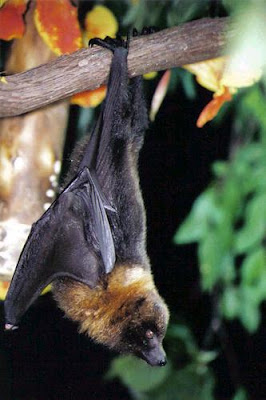Ein weiterer Bohnenbaum, der ein Fledermaus-bzw.Flughundbaum ist. . . Der Tamarindenbaum teilt eine botanische Familie und eine Fledermausassoziation mit dem Schwarzbohnenbaum, dem Petai-Baum, dem Johannisbrotbaum, dem westindischen Heuschreckenbaum und dem westafrikanischen Heuschreckenbaum. Ein weiterer Fledermausbaum, der vielfältig genutzt werden kann: Lebensmittel, Holz, Medikamente, Brennstoffe und viele andere Gegenstände, die in Privathaushalten und in kommerziellen Prozessen nützlich sind. Ein weiterer Fledermausbaum, der so viele menschliche Verwendungszwecke hat, dass er von den Menschen, die sein langes Leben teilen, als heiliger Baum angesehen wird. Der Tamarindenbaum stammt aus Afrika, ist aber in tropischen Ländern weit verbreitet. Es ist bekannt, dass die Samen von Flughunden in Australien und von Rodrigues-Flughunden auf den Inseln des Westindischen Ozeans gepflanzt werden.-
Another bean tree that is a bat tree . . . the tamarind tree shares a botanical family and a bat association with the blackbean tree, the petai tree, the carob tree, the West Indian locust tree and the West African locust tree. Another bat tree that has a multiplicity of uses: food, timber, medicine, fuel, and many items useful in homes and in commercial processes. Another bat tree that has so many human uses that it is regarded by the people who share its long life as a sacred tree. The tamarind tree is a native of Africa but is widespread in tropical countries. The seeds are known to be planted by flying foxes in Australia and by the Rodrigues flying fox in West Indian Ocean islands.
source:wikipedia
Photo credits & source: Laura Linke
Das Fruchtfleisch der Schoten ist so lecker, dass die Samen neben den Flughunden von einer Vielzahl wertschätzender Kreaturen weitergetragen und damit vermehrt werden.
The pulp of the pods is so tasty that the seeds are dispersed and planted by a variety of appreciative creatures besides the flying foxes.
Der Baum bietet auch eine Reihe anderer essbarer Verwendungszwecke sowie eine breite Palette von medizinischen Anwendungen und anderen Verwendungszwecken. Als nächstes folgt eine Liste einiger Verwendungszwecke von Tamarindenbäumen: Schön anzusehen, hoch mit Spitzenlaub, als Zierbaum gepflanzt.
Lebensmittel: Blätter, Blüten, junge Schoten, reife unreife Schoten, reife Schoten und Fruchtfleisch: Das Fruchtfleisch wird zu Chutneys, Konfekt, Getränken, Sirup, Eis und Wein verarbeitet.
Kommerzielle Verwendung: Samen - verarbeitet für Pektin, Zellstoff - Färbefixiermittel, Blätter - Tierfutter, Seidenraupenfutter, Farbstoff, Bleichmittel, Blüten - Honigbienenfutter, Samenpulver - Textilleimung, Kunststoffherstellung, Leim-, Ziegel- und Brikettbestandteil, Lederbehandlung, Öl- Lampen, Lack, Holz - Möbel, Räder, Pflüge, Bootsbretter, Schlägel, Mörser, Stößel, Spazierstöcke, Zweige - Kaustöcke Rindenbräunung, Tinte, Schnur
Medizin - Behandlung für jede erdenkliche Krankheit, einschließlich Fieber, Verstopfung, Durchfall, schlechte Verdauung, Leber- und Gallenstörung, Entzündungen, Halsschmerzen, Rheuma, Sonnenstich, Vergiftung, Lähmung, geschwollene Gelenke, Verstauchungen, Furunkel, entzündete Augen, Ruhr, Hämorrhoiden, Koliken, Gingivitis, Asthma, Wunden, Raupenausschläge, Lepra
Next follows a list of some tamarind tree uses: Beautiful to behold, tall with lacy foliage, it is planted as an ornamental tree.
Food: leaves, flowers, young pods, mature unripe pods, ripe pods and pulp: The pulp is made into chutneys, confections, drinks, syrup, ice cream and wine.
Commercial uses: Seeds - processed for pectin, Pulp - dyeing fixative, Leaves - animal fodder, silkworm food, dye, bleach, Flowers - honey bee forage, Seed powder - textile sizing, plastic manufacture, glue, brick and briquette component, leather treatment, Oil - lamps, varnish, Timber - furniture, wheels, ploughs, boat planking, mallets, mortars, pestles, walking sticks, Twigs - chew sticks, Bark - tanning, ink, twine and string.
Medicine - treatment for every imaginable ailment including fever, constipation, diarrhea, poor digestion, liver and bile disorder, inflammations, sore throat, rheumatism, sunstroke, intoxication, paralysis, swollen joints, sprains, boils, inflamed eyes, dysentery, hemorrhoids, colic, gingivitis, asthma,sores, caterpillar rashes, leprosy.
Bahamian children hold mature but still green tamarinds
in hot ashes until they sizzle, then dip the tip in the ashes and eat
them.The high calcium content contributes to good teeth, source
Another comprehensive article on the Tamarind tree and its virtues I found here with many more details, I liked especially the part about superstitions....
Few plants will survive beneath a tamarind tree and there is a superstition that it is harmful to sleep or to tie a horse beneath one, probably because of the corrosive effect that fallen leaves have on fabrics in damp weather. Some African tribes venerate the tamarind tree as sacred. To certain Burmese, the tree represents the dwelling-place of the rain god and some hold the belief that the tree raises the temperature in its immediate vicinity. In Nyasaland, tamarind bark soaked with corn is given to domestic fowl in the belief that, if they stray or are stolen, it will cause them to return home. In Malaya, a little tamarind and coconut milk is placed in the mouth of an infant at birth, and the bark and fruit are given to elephants to make them wise.
Ein Korb mit Leckerbissen für Elefanten mit Tamarinde für die Erlangung von Weisheit. Was für die Elefanten gilt, könnte doch auch für uns gelten ...-
A basket of treat for elephants with tamarind for wisdom, what goes for the elephants might go for us too...
Die Blüte des Tamarindenbaums in Rodrigues liegt zwischen Mitte September und Mitte Oktober, da ich selber nicht unmittelbar von Tamarindenbäumen umgeben bin, verpasse ich zumeist diese Zeit, deshalb habe ich selbst keine Fotos.-
By the way, in Rodrigues the flowering season of the tamarand tree is in September and ends by middle of October, as I have no tamarind tree in my immediate surrounding I almost always miss the flowering, that's why I don't have photos myself ...
Pollination in action: Apis florea bee (dwarf honey bee), photo source
Sources & related:
- Tamarindenbaum on wikipedia, dt., engl.
- Tamarind balls as elephant treat/facebook video clip






























Keine Kommentare:
Kommentar veröffentlichen